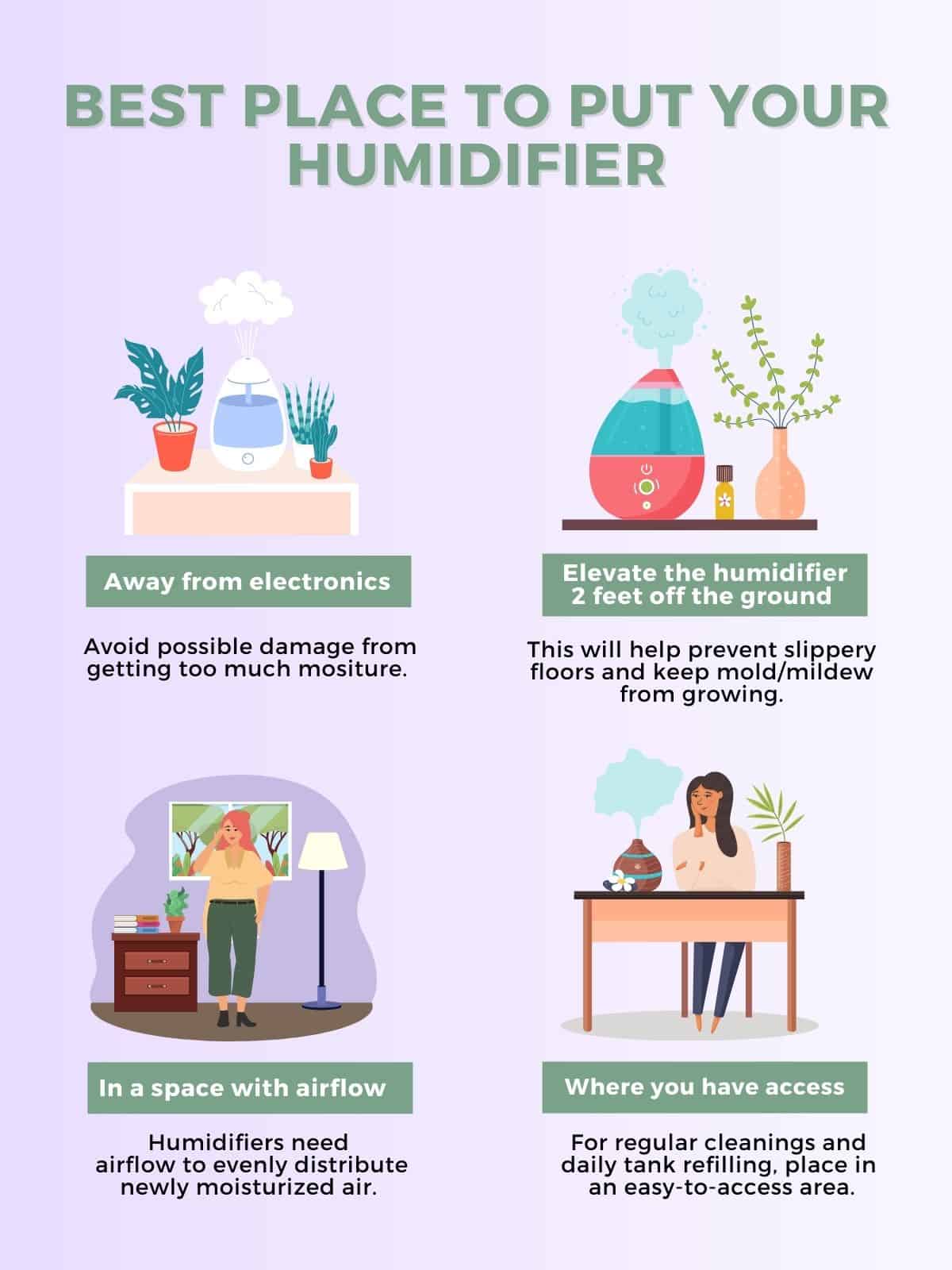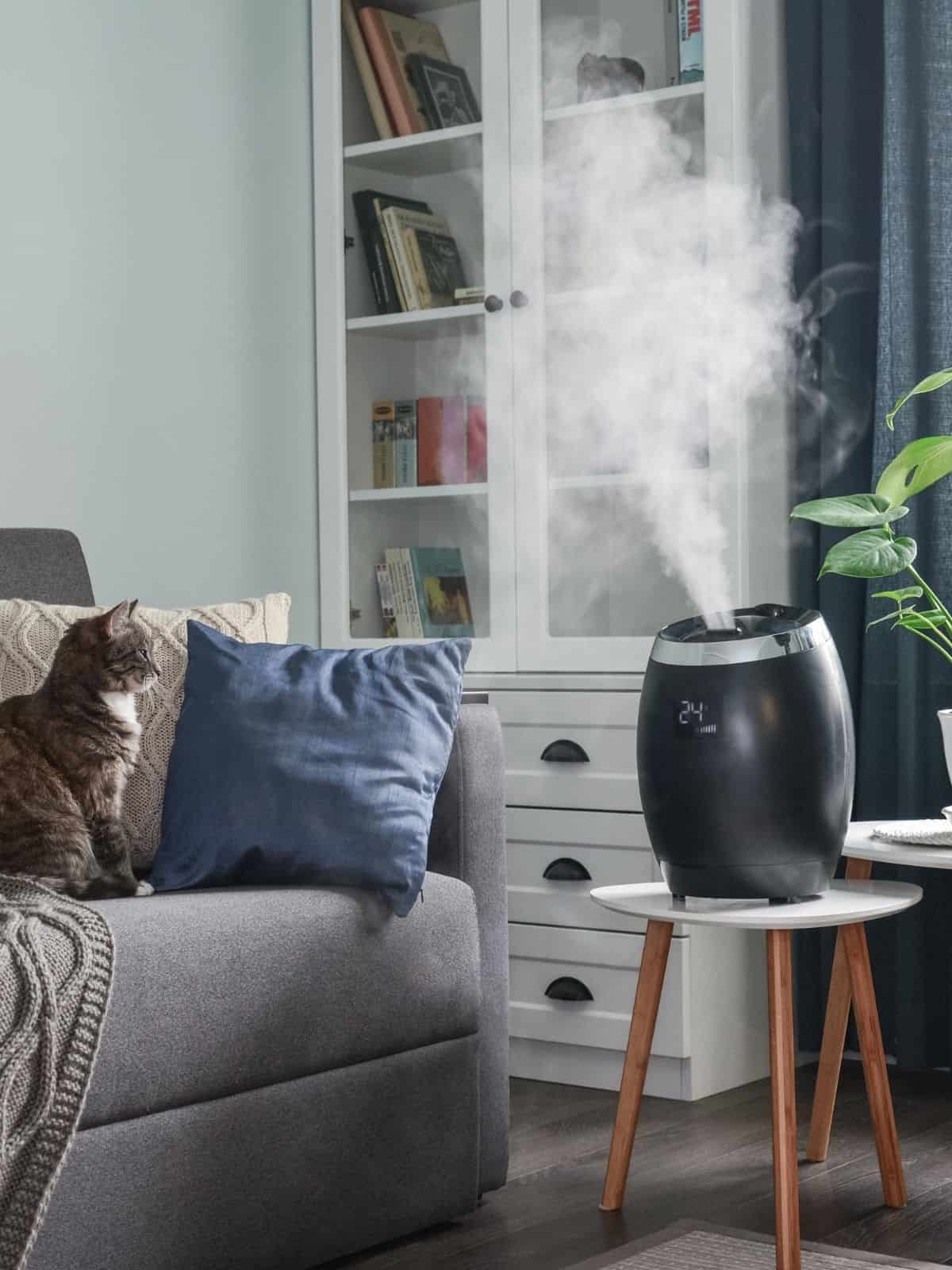Humidifiers are excellent to have around the house – whether you want to add some moisture back into dry air to protect your skin or to help your plants thrive, humidifiers can serve many purposes
However, to enjoy the full benefits of your humidifier, you should be sure that you’re following all the right protocols – including choosing the best place to put a humidifier.
In this article, we’ll dig into where you should put your new humidifier to enjoy maximum benefits, as well as why you should have a humidifier in the first place and helpful tips for first-timers.

Why Use a Humidifier?
Humidifiers offer a ton of benefits for your health as well as your home. Especially in winter months when we are pumping dry, hot air in through our heating systems, the air we’re constantly breathing is devoid of moisture.
This can cause dry, bloody noses, uncomfortable dry skin and eyes, and static electricity. Not only are these conditions uncomfortable and annoying, but static electricity can also damage your electronics, like your computer.
Humidifiers work to release moisture into the air, helping you breathe easier, sleep better, and wake up more comfortably, without the bloody nose or painful dry skin. Electronics can last longer, as can your wallpaper and paint, which tend to dry up and peel when the air is dry.
Any indoor plants will also thrive since most need at least 23% humidity when the temperatures reach below freezing.
Perhaps most important, though, is that humidifiers can potentially limit airborne viruses. You may notice that in the winter months, colds and flus run rampant. This is because these viruses do better and spread further with dry, indoor air. A humidifier limits their ability to spread by increasing the moisture in your air.

Where Should You Put Your Humidifier?
Humidifiers are a really simple solution to so many of the issues we experience in the winter. Thankfully, they’re also really simple to use! With that said, it is important that you scope out the best place to put a humidifier in your home. Even a large, strong humidifier won’t be very effective if you put it in a place where it can’t operate properly.
The following factors are key when choosing a home for your humidifier:
Room Size
We may often want to tuck appliances, like humidifiers, away in a corner where they won’t be noticed. However, doing so limits your access to moisturized air, which means also limiting your access to the benefits. This is especially true in large spaces – if you’re trying to humidify a large bedroom, living room, house, office or classroom you’ll need to make sure you put the humidifier in a central location. This ensures that moisture will be evenly distributed throughout the area.
While humidifiers can help electronics by avoiding static electricity, it’s still important that you don’t put your humidifier directly next to any electronics. Things like your Wi-Fi router or laptop won’t do well if they’re getting the brunt of the moist air emitting from your humidifier – plus, there’s always a chance that your humidifier might leak. Worse still, someone might knock the humidifier over and water from the tank could potentially spill out. The same can be said for anything else that could be damaged from getting wet – books, papers, and the like should be kept away from your humidifier.
Humidifiers do require a bit of daily upkeep, so you should place them where you have easy access. They aren’t a “set it and forget it” type of appliance – from regular cleanings to daily tank refilling, you’ll make your life easier by setting up the humidifier in an easy-to-access area.
Perhaps the most important consideration when finding the best place to put a humidifier is airflow. The humidifier won’t work if it doesn’t have adequate access to air – without this, it can’t take in all of the room’s air or evenly distribute newly moisturized air. Make sure that wherever you put your humidifier, there’s nothing blocking it from drawing air in – for example, nearby curtains or knick-knacks dominating the space directly beside the unit. On the flip side, you could also cause a moisture build-up in a small area if the humidifier doesn’t have enough air to humidify.

Additional Tips for Getting the Most Benefits from Your Humidifier
While placement is key, there are a few other things to consider to ensure you get the most from your humidifier. Consider the following:
- Make sure you get the right size humidifier for the room that you want to use it in. A small humidifier in a huge room won’t be able to distribute moisture to the entire room. Likewise, a large humidifier in a small space can cause a build-up of moisture, which can have negative impacts.
- Avoid putting your humidifier near air vents or windows. This can throw off your humidity reading. If you have a self-regulating machine, this can impact how it runs. If you check the humidity yourself, you will likely be confused as to why your humidifier says the room is humidified yet you have dry skin, or vice versa.
- Use distilled or purified water and avoid tap water or hard water. Even if you choose the perfect place for your humidifier, unfiltered water contains minerals that can cause a build-up in your unit as well as push minerals into the air, where they can irritate the people breathing them in.

Final Thoughts
While humidifiers can’t treat any underlying conditions, they can make daily life, especially for people with skin issues and respiratory problems, much more comfortable. Whether you hate waking up with dry eyes and nose or want to stop the common cold from spreading in your home, a humidifier is a great choice. Just be sure to find the best place for a humidifier before committing – preferably in a central location, with plenty of airflow that is easily accessible. If you do this, you’ll be enjoying the rewards in no time!
Other Articles You Might Like!
Top 2021 Vent & USB Diffusers For Cars
